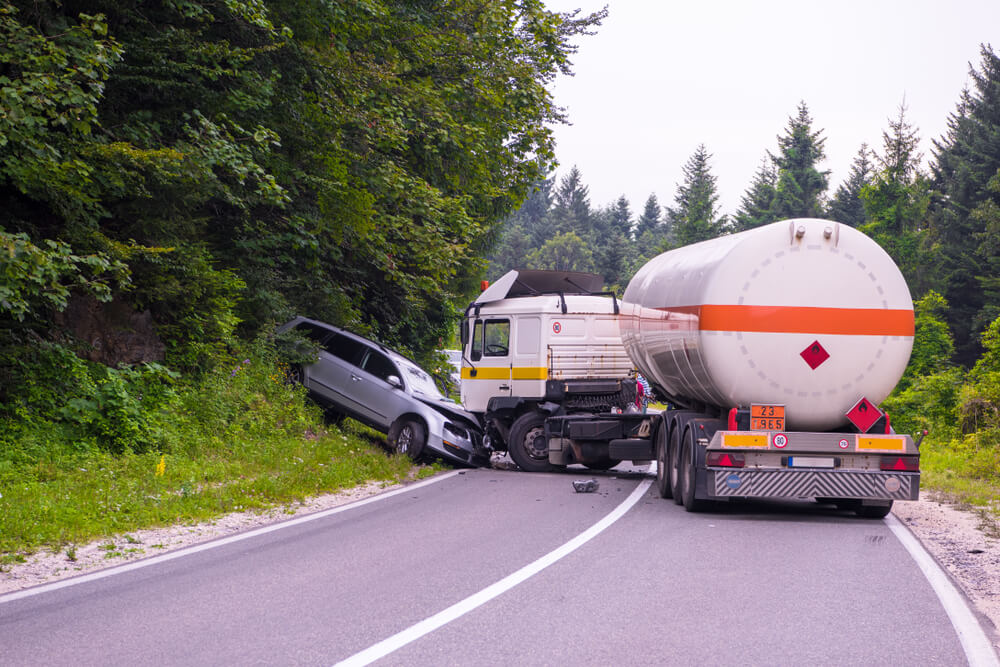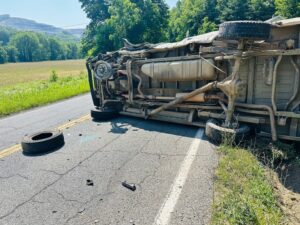
Unlike front or rear collisions, where your vehicle’s crumple zones absorb energy, side-impact crashes leave only a door panel, window, and narrow side airbag between you and tens of thousands of pounds of moving steel. When a commercial truck strikes the side of your vehicle at an intersection, causing a “T-bone” or side-impact crash, the results for you and your passengers can be catastrophic.
Pennsylvania’s rural two-lane highways, busy Interstate interchanges, and industrial corridors around Indiana, State College, DuBois, Altoona, and Johnstown see these crashes regularly. Drivers hauling coal, industrial equipment, and freight through Central and Western Pennsylvania face tight delivery schedules, complex intersections, and challenging sight lines, a combination that turns red-light violations and failed left turns into life-threatening collisions.
 The physics of a side-impact crash explain why injuries are so serious. When the front of a tractor-trailer strikes the side of a passenger car, that energy transfers directly into the occupant compartment. Side airbags and door beams help, but they cannot stop the massive weight and momentum from crushing door frames, collapsing B-pillars, and pushing vehicles sideways across intersections.
The physics of a side-impact crash explain why injuries are so serious. When the front of a tractor-trailer strikes the side of a passenger car, that energy transfers directly into the occupant compartment. Side airbags and door beams help, but they cannot stop the massive weight and momentum from crushing door frames, collapsing B-pillars, and pushing vehicles sideways across intersections.
An 80,000-pound semi-truck traveling at even low rates of speed carries enormous kinetic energy that can crush B-pillars, collapse door frames, and push vehicles sideways across intersections.
Occupants seated on the struck side absorb the full force, suffering injuries that include:
Truck length and blind spots add another layer of risk at intersections. Large commercial trucks have significant blind spots on all four sides. A trucker waiting to turn left may not see a smaller vehicle, motorcycle, or pedestrian crossing in front of them. Drivers making right turns on red may fail to check for cross traffic hidden in their blind spots before accelerating into the intersection.
Most side-impact truck collisions occur at intersections and merge points where traffic streams cross. Trucks may enter traffic for various reasons, leading to side-impact crashes.
A truck driver approaching a stale green light misjudges the yellow phase or tries to beat the red. Commercial trucks need 525 feet to stop from 65 mph on dry pavement, nearly twice the stopping distance of a passenger car. That makes split-second yellow-light decisions far more dangerous when a loaded semi is involved. When the light turns red and cross traffic starts moving, the truck barrels through the intersection and strikes vehicles proceeding on a green signal.
Pennsylvania law requires drivers turning left to yield to oncoming traffic. Truckers face a difficult calculation: they must estimate the speed and distance of approaching vehicles while managing a 70-foot-long combination that turns slowly and blocks multiple lanes. Misjudging an oncoming car’s speed by just a few miles per hour, or failing to see a motorcycle or smaller vehicle, results in the truck pulling directly into the path of cross traffic.
At four-way stops, the first vehicle to arrive proceeds first. Truck drivers who roll through stop signs, fail to wait their turn, or misjudge right-of-way create collision risks. Rural intersections with limited sight distance due to hills, curves, or roadside vegetation make these violations especially dangerous.
Federal Motor Carrier Safety Administration rules limit truck drivers to 11 hours of driving after 10 consecutive hours off duty. Drivers who falsify electronic logging device records or exceed limits to meet delivery deadlines suffer slower reaction times, impaired judgment, and microsleep episodes. Fatigue contributes to red-light violations and intersection misjudgments because exhausted drivers process visual information more slowly.
Truck drivers are prohibited from texting or holding hand-held phones while operating commercial vehicles. Cell-tower records, call logs, and cab video show whether a driver was distracted by a phone, dispatch message, GPS device, or meal while approaching an intersection. Even a two-second glance away from the road at 50 mph means traveling 147 feet blind.
Worn brake pads, broken turn signals, and steering defects contribute to intersection crashes when drivers cannot stop in time or fail to signal their intentions. Federal regulations require trucking companies to maintain vehicles in safe operating condition and conduct pre-trip inspections, but some carriers cut corners on maintenance to keep trucks moving.
Pennsylvania follows modified comparative negligence, which means you may recover damages as long as your share of fault stays below 51%. If your fault reaches 51% or more, you recover nothing.
Defense attorneys may argue comparative fault aggressively in side-impact truck cases. Some possible arguments may be:
Strong evidence can counter and minimize these comparative-fault arguments, protecting your recovery.
Comparative negligence also affects settlement negotiations. Insurance adjusters may use it to reduce offers even when liability seems clear. Building a complete evidentiary record early limits this leverage.
No “average” settlement exists because each case depends on the specific circumstances of the tractor-trailer accident. Pennsylvania does not cap economic or non-economic damages in personal injury cases, so the following factors will ultimately impact your compensation.
Emergency transport, trauma surgery, ICU stays, rehabilitation, physical therapy, prescription medications, durable medical equipment, and home modifications create immediate costs. Future surgeries, ongoing pain management, and lifetime attendant care for spinal-cord injuries and traumatic brain injuries multiply expenses over decades.
Time away from work for treatment creates immediate lost income. Permanent disability reduces or eliminates your ability to return to your prior occupation. When necessary, vocational experts calculate the present value of lost earnings over your remaining work-life expectancy, accounting for raises, benefits, and career progression you would have achieved.
Physical pain, emotional distress, anxiety, depression, and post-traumatic stress disorder from the collision and its aftermath warrant non-economic damages. Juries consider injury severity, treatment duration, permanence, and impact on daily activities, like sleeping, walking, lifting children, and enjoying hobbies.
If the T-bone crash killed a family member, Pennsylvania law permits recovery of funeral expenses, loss of the decedent’s earning power, and loss of care, guidance, and companionship. Survival-action damages include the decedent’s pre-death pain, suffering, and medical bills.
Federal law mandates higher minimums for trucks than for passenger vehicles, so commercial truck policies typically carry $750,000 to $1 million in primary liability coverage, plus excess layers. Policies from other liable parties and the driver’s personal auto policy sometimes stack, increasing available compensation.
Clear red-light violations, hours-of-service breaches, or distracted-driving evidence compel higher offers because the defense faces trial risk and potential punitive damages. Disputed fault or comparative negligence lowers settlement leverage.
Moreover, carriers with poor safety ratings, prior violations, or patterns of inadequate driver training face heightened liability and may settle early to avoid public discovery into systemic negligence.
 Liability in a broadside truck crash turns on who violated traffic laws and right-of-way rules. Marcus & Mack truck accident lawyers build cases by securing evidence that disappears quickly, often within days, if not properly preserved.
Liability in a broadside truck crash turns on who violated traffic laws and right-of-way rules. Marcus & Mack truck accident lawyers build cases by securing evidence that disappears quickly, often within days, if not properly preserved.
Black-box (EDR) downloads extract speed, throttle position, brake application, and GPS location from the truck’s engine control module in the seconds before impact. Comparing EDR timestamps to traffic-signal timing records proves whether the truck entered on red or had time to stop safely.
Electronic logging device (ELD) records track driving hours, rest breaks, and duty status. These logs reveal whether the driver exceeded the 11-hour driving limit or violated the 14-hour on-duty window, pointing to fatigue as a contributing factor.
Dashcam and surveillance footage from the truck’s cab, nearby businesses, traffic cameras, and bystander phones captures the collision from multiple angles, confirming right-of-way and driver behavior in real time.
Scene documentation preserves skid marks, yaw marks, debris patterns, crush depth, and vehicle rest positions. Marcus & Mack works with accident-reconstruction engineers, when necessary, who can photograph and measure these features within hours, before weather or traffic erases them, then use the data to calculate pre-impact speed and point of no return.
Eyewitness statements from passengers, pedestrians, and drivers in adjacent lanes provide independent accounts of signal status, vehicle speed, and driver actions. Early interviews produce more reliable testimony than waiting weeks or months.
Cell-phone records subpoenaed from carriers establish whether the truck driver was texting or calling at the moment of the collision, violating federal rules.
Driver qualification files maintained by the trucking company include the driver’s record, medical certificate, road tests, and prior crashes. Patterns of red-light violations, previous at-fault collisions, or failed drug tests expose negligent hiring and retention practices.
Traffic-signal engineering records from municipal authorities document signal-phase duration, yellow-light length, and pedestrian-clearance intervals, proving whether the truck had adequate time and distance to stop.
Your health insurance, auto insurance medical-benefits coverage, or Pennsylvania no-fault benefits typically pay initial bills, then seek reimbursement from the at-fault party’s liability insurer through subrogation once the case settles.
No. Politely decline and refer the adjuster to your attorney once you hire one. Recorded statements and informal conversations give the defense free information about your version of events, medical history, employment status, and credibility—without the protections of formal depositions.
You have two years, and missing the deadline forfeits your right to compensation regardless of injury severity. The clock starts ticking the day the crash occurs, so filing early preserves evidence before trucking companies overwrite black-box data, purge ELD logs, or erase dashcam footage.
Your own uninsured-motorist and underinsured-motorist coverage applies; Pennsylvania law requires insurers to offer UM/UIM limits equal to your liability limits unless you reject them in writing.
Most settle before trial, but you must be prepared to testify if negotiations fail; having trial-ready evidence and expert witnesses strengthens settlement leverage.
 Side-impact truck crashes leave victims facing catastrophic injuries, aggressive insurance companies, and tight evidence-preservation deadlines. Acting quickly by securing the scene, documenting injuries, preserving evidence, and consulting an experienced truck-accident attorney protects your ability to prove fault and recover fair compensation.
Side-impact truck crashes leave victims facing catastrophic injuries, aggressive insurance companies, and tight evidence-preservation deadlines. Acting quickly by securing the scene, documenting injuries, preserving evidence, and consulting an experienced truck-accident attorney protects your ability to prove fault and recover fair compensation.
Marcus & Mack investigates trucking companies, representing T-bone truck accident victims throughout Central and Western Pennsylvania. Our five offices in Indiana (PA), State College, DuBois, Altoona, and Johnstown serve residents and commuters who need local access backed by experienced trial preparation.
Contact us now for a free consultation at one of our five offices:
We work on contingency, so you pay no fee unless we win.
Marcus & Mack
